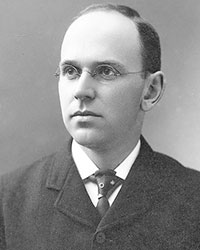Support Joslin
Together, we can and will create a world without diabetes. Help us help the ones you love.
The inspiring story of Elliott P. Joslin, MD
In the late 19th century, diabetes was considered a very obscure disease, and there was little in the way of treatment. But, both personal and professional experiences led Elliott P. Joslin, MD to become one of the few doctors to pursue diabetes care.
Dr. Joslin was born in 1869 in Oxford, Massachusetts. Later he attended Yale University and Harvard Medical School. While he was in college, Dr. Joslin's Aunt Helen was diagnosed with diabetes. He studied her disease, and coincidentally, was assigned to treat a student with diabetes during his third year in medical school.
During this time, he was challenged by the outcomes of diabetes patients and began creating a list of his patients in large accounting books, complete with all the facts, progress, and outcomes. This was the beginning of the first diabetes registry in the world. Then, he compared his data with public statistics — and the field of diabetes epidemiology launched.
The enormous amount of data Dr. Joslin collected was written in ledgers, referred to as the “black books.” He was ahead of anyone in terms of compiling diabetes statistics — so much so that the Metropolitan Life Insurance Company arranged to use Dr. Joslin’s statistics for their actuarial tables. This remains the largest collection of clinical data on diabetes in the world.
Two years later he published the Diabetic Manual — for the Doctor and Patient. This was the first diabetes patient handbook, and it detailed how patients could take control of the disease. The significance of this book can’t be overemphasized — educating patients about diabetes was the first step toward people feeling empowered instead of victimized by the disease. This became a hallmark of Joslin's care approach.
In addition to putting patients front and center, Dr. Joslin expanded the role of nurses in 1923, just two years after the discovery of insulin. “Wandering nurses” would go out into the community to instruct people with diabetes about insulin management, diet, and exercise. Today we call these nurses certified diabetes educators.
Dr. Joslin also was the first physician to name diabetes as a serious public health issue. Just after WWII, he lamented to the Surgeon General of the U.S. Public Health Service that diabetes was an epidemic and challenged the government to do a study in the town of his birthplace, Oxford. The study began in 1946 and was carried out over the next 20 years. The results confirmed Dr. Joslin's belief that diabetes was an epidemic. As a result, diabetes was named a public health issue for the first time.
Dr. Joslin saw his first patient in 1898 at his parents' townhouse at 517 Beacon Street. He practiced at Beacon Street until late 1905 when he moved his office to 81 Bay State Road. His townhouse and the building next door served as his practice for the next 50 years. In 1956 the office was moved to the Longwood Medical Area. Joslin Diabetes Center is the world’s first diabetes care facility.
 Ironically, Dr. Joslin's own mother was diagnosed with diabetes just one year after he began his practice. Her progress and the work of a German professor shaped his theory about how diabetes should be managed and influenced his future thinking on the matter — diagnose diabetes early, treat the condition vigorously and encourage the patient to get regular exercise.
Ironically, Dr. Joslin's own mother was diagnosed with diabetes just one year after he began his practice. Her progress and the work of a German professor shaped his theory about how diabetes should be managed and influenced his future thinking on the matter — diagnose diabetes early, treat the condition vigorously and encourage the patient to get regular exercise.
He assembled 1,000 of his own cases into the first diabetes textbook, The Treatment of Diabetes Mellitus, in which he outlined how he reduced the death rate of his patients by 20 percent. This was the beginning of Dr. Joslin's theory that managing tight control of one’s blood glucose through diet, exercise, and constant testing could extend one’s life and prevent complications.
Dr. Joslin’s practice grew enormously after insulin was introduced. He worked with other diabetes specialists, such as Leo Krall, MD, Howard Root, MD, and Priscilla White, MD, and they all followed Dr. Joslin's way of treating the patient using a team approach.
The Joslin practice reflected Dr. Joslin's early writings and his theory of strict control of blood glucose, frequent testing, and daily exercise to prevent diabetes complications. One distinctive characteristic of this approach involves his belief in the “troika,” the Russian word meaning a vehicle pulled by three horses. Dr. Joslin created a three horse chariot symbol to reflect his philosophy of living with diabetes — the three horse motif symbolized Diet, Exercise and Insulin, which are all needed to achieve victory over diabetes.
Dr. Joslin's approach to diabetes management was debated for decades by other endocrinologists and scientists. He did not live to see his theory validated. Dr. Joslin died in 1962 at the age of 92, at his home in Brookline, Massachusetts.
It wasn’t until 1993 that his approach was supported by the 10-year study, “The Diabetes Control and Complications Trial Report,” published in the prestigious New England Journal of Medicine. The study demonstrated that the onset of diabetes complications was delayed by tight blood glucose control.


Together, we can and will create a world without diabetes. Help us help the ones you love.